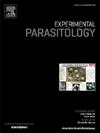麻花乙醇提取物的抗疟潜力、毒理学影响及气相色谱-质谱分析
IF 1.4
4区 医学
Q3 PARASITOLOGY
引用次数: 0
摘要
疟疾仍然是一个重大的全球卫生挑战,需要新的治疗方法。本研究旨在探讨红花螺叶乙醇提取物对疟疾感染小鼠寄生虫血症、血液学指标、氧化应激、肝肾功能和血清电解质水平的影响。实验小鼠感染伯氏螺旋体,并给予分级剂量的红柱体乙醇提取物。测量血液学参数(RBC、WBC、血小板计数、Hb、PCV)、抗氧化酶活性(CAT、SOD、GPx)、氧化应激标志物、肝功能生物标志物(ALP、AST、ALT、总胆红素)、肾功能生物标志物(尿素、肌酐、直接胆红素)和电解质水平(Na+、K+、Cl−、HCO3−)。不同剂量的提取物与标准药物一起显著抑制寄生虫的生长。提取物可显著改善血液学指标,对SOD活性无显著影响。CAT活性在100 mg/kg时升高,GPX活性在200 mg/kg时最低。200 mg/kg时MDA水平显著降低。AST和ALP活性呈剂量依赖性变化,在200 mg/kg时达到峰值。ALT和总胆红素水平保持稳定。直接胆红素水平在100和200 mg/kg时升高,而尿素和肌酐在较高剂量时表明肾脏应激。钠和钾水平呈剂量依赖性下降,Cl -和HCO3 -水平稳定。经GC-MS分析,共发现65种生物活性成分。该提取物显示出显著的抗氧化和抗疟疾特性,其稳定的电解质水平和低肝脏应激意味着安全性。为了确定精确的抗疟疾生物活性成分及其作用方式,需要进行更多的研究。最后,从棘球蚴的乙醇提取物显示出作为疟疾辅助治疗的希望。本文章由计算机程序翻译,如有差异,请以英文原文为准。

Antimalarial potentials, toxicological impacts, and gas chromatography-mass spectrometric analysis of ethanol extract of Spondias mombin Linn
Malaria remains a significant global health challenge, necessitating new treatment approaches. This study aimed to investigate the effects of ethanol extract from Spondias mombin leaves on parasitemia, hematological parameters, oxidative stress, liver and kidney function, and serum electrolyte levels in malaria-infected mice. The experimental mice were infected with P. berghei and treated with graded doses of Spondias mombin ethanol extract. Hematological parameters (RBC, WBC, platelet count, Hb, PCV), antioxidant enzyme activities (CAT, SOD, GPx), oxidative stress markers, liver function biomarkers (ALP, AST, ALT, total bilirubin), kidney function biomarkers (urea, creatinine, direct bilirubin), and electrolyte levels (Na+, K+, Cl−, HCO3−) were measured. Different doses of the extract alongside the standard drug significantly inhibited parasite growth. The extract significantly improved hematological parameters and showed no significant effect on SOD activity. CAT activity increased at 100 mg/kg, while GPX activity was highest in controls and lowest at 200 mg/kg. MDA levels decreased significantly at 200 mg/kg. AST and ALP activities varied dose-dependently, reaching a peak at 200 mg/kg. ALT and total bilirubin levels remained stable. Direct bilirubin levels increased at 100 and 200 mg/kg, while urea and creatinine indicated renal stress at higher doses. Sodium and potassium levels decreased dose-dependently, with stable Cl− and HCO3− levels. A total of 65 bioactive components were found following the results of the GC-MS analysis. Significant antioxidant and antimalarial properties are shown by this extract, and its steady electrolyte levels and low liver stress imply safety. To identify the precise antimalarial bioactive components and their modes of action, more investigation is required. Conclusively, ethanol extract from Spondias mombin shows promise as a malaria adjuvant treatment.
求助全文
通过发布文献求助,成功后即可免费获取论文全文。
去求助
来源期刊

Experimental parasitology
医学-寄生虫学
CiteScore
3.10
自引率
4.80%
发文量
160
审稿时长
3 months
期刊介绍:
Experimental Parasitology emphasizes modern approaches to parasitology, including molecular biology and immunology. The journal features original research papers on the physiological, metabolic, immunologic, biochemical, nutritional, and chemotherapeutic aspects of parasites and host-parasite relationships.
 求助内容:
求助内容: 应助结果提醒方式:
应助结果提醒方式:


